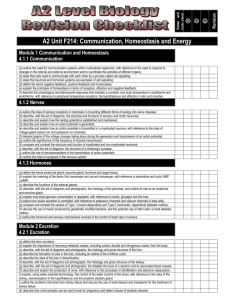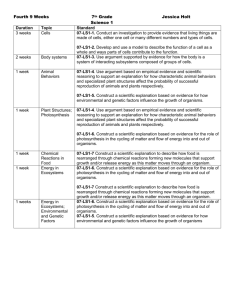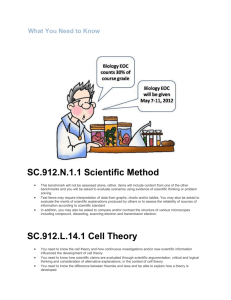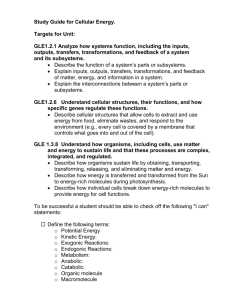A2 Syllabus
advertisement
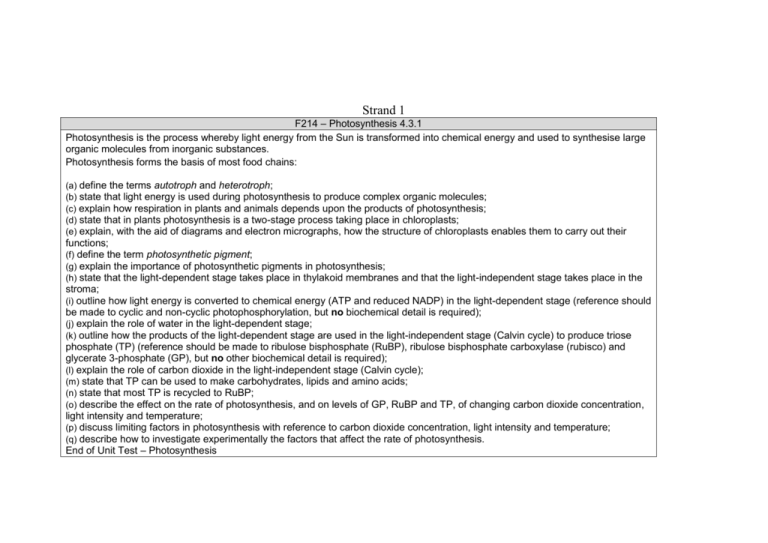
Strand 1 F214 – Photosynthesis 4.3.1 Photosynthesis is the process whereby light energy from the Sun is transformed into chemical energy and used to synthesise large organic molecules from inorganic substances. Photosynthesis forms the basis of most food chains: (a) define the terms autotroph and heterotroph; (b) state that light energy is used during photosynthesis to produce complex organic molecules; (c) explain how respiration in plants and animals depends upon the products of photosynthesis; (d) state that in plants photosynthesis is a two-stage process taking place in chloroplasts; (e) explain, with the aid of diagrams and electron micrographs, how the structure of chloroplasts enables them to carry out their functions; (f) define the term photosynthetic pigment; (g) explain the importance of photosynthetic pigments in photosynthesis; (h) state that the light-dependent stage takes place in thylakoid membranes and that the light-independent stage takes place in the stroma; (i) outline how light energy is converted to chemical energy (ATP and reduced NADP) in the light-dependent stage (reference should be made to cyclic and non-cyclic photophosphorylation, but no biochemical detail is required); (j) explain the role of water in the light-dependent stage; (k) outline how the products of the light-dependent stage are used in the light-independent stage (Calvin cycle) to produce triose phosphate (TP) (reference should be made to ribulose bisphosphate (RuBP), ribulose bisphosphate carboxylase (rubisco) and glycerate 3-phosphate (GP), but no other biochemical detail is required); (l) explain the role of carbon dioxide in the light-independent stage (Calvin cycle); (m) state that TP can be used to make carbohydrates, lipids and amino acids; (n) state that most TP is recycled to RuBP; (o) describe the effect on the rate of photosynthesis, and on levels of GP, RuBP and TP, of changing carbon dioxide concentration, light intensity and temperature; (p) discuss limiting factors in photosynthesis with reference to carbon dioxide concentration, light intensity and temperature; (q) describe how to investigate experimentally the factors that affect the rate of photosynthesis. End of Unit Test – Photosynthesis F214 Respiration 4.4.1 Respiration is the process whereby energy stored in complex organic molecules is transferred to ATP. ATP provides the immediate source of energy for biological processes: (a) outline why plants, animals and microorganisms need to respire, with reference to active transport and metabolic reactions; (b) describe, with the aid of diagrams, the structure of ATP; (c) state that ATP provides the immediate source of energy for biological processes; (d) explain the importance of coenzymes in respiration, with reference to NAD and coenzyme A; (e) state that glycolysis takes place in the cytoplasm; (f) outline the process of glycolysis beginning with the phosphorylation of glucose to hexose bisphosphate, splitting of hexose bisphosphate into two triose phosphate molecules and further oxidation to pyruvate, producing a small yield of ATP and reduced NAD; (g) state that, during aerobic respiration in animals, pyruvate is actively transported into mitochondria; (h) explain, with the aid of diagrams and electron micrographs, how the structure of mitochondria enables them to carry out their functions; (i) state that the link reaction takes place in the mitochondrial matrix; (j) outline the link reaction, with reference to decarboxylation of pyruvate to acetate and the reduction of NAD. (k) explain that acetate is combined with coenzyme A to be carried to the next stage; (l) state that the Krebs cycle takes place in the mitochondrial matrix; (m) outline the Krebs cycle, with reference to the formation of citrate from acetate and oxaloacetate and the reconversion of citrate to oxaloacetate (names of intermediate compounds are not required); (n) explain that during the Krebs cycle, decarboxylation and dehydrogenation occur, NAD and FAD are reduced and substrate level phosphorylation occurs; (o) outline the process of oxidative phosphorylation, with reference to the roles of electron carriers, oxygen and the mitochondrial cristae; (p) outline the process of chemiosmosis, with reference to the electron transport chain, proton gradients and ATPsynthase (HSW7a); (q) state that oxygen is the final electron acceptor in aerobic respiration; (r) evaluate the experimental evidence for the theory of chemiosmosis (HSW1); (s) explain why the theoretical maximum yield of ATP per molecule of glucose is rarely, if ever, achieved in aerobic respiration; (t) explain why anaerobic respiration produces a much lower yield of ATP than aerobic respiration; (u) compare and contrast anaerobic respiration in mammals and in yeast; (v) define the term respiratory substrate; (w) explain the difference in relative energy values of carbohydrate, lipid and protein respiratory substrates. End of Unit test – Respiration F214 Excretion 4.2.1 The kidneys, liver and lungs are all involved in the removal of toxic products of metabolism from the blood. The liver also metabolises toxins that have been ingested. The kidneys also play a major role in the control of the water potential of the blood: (a) define the term excretion; (b) explain the importance of removing metabolic wastes, including carbon dioxide and nitrogenous waste, from the body; (c) describe, with the aid of diagrams and photographs, the histology and gross structure of the liver; (d) describe the formation of urea in the liver, including an outline of the ornithine cycle; (e) describe the roles of the liver in detoxification; (f) describe, with the aid of diagrams and photographs, the histology and gross structure of the kidney; (g) describe, with the aid of diagrams and photographs, the detailed structure of a nephron and its associated blood vessels; (h) describe and explain the production of urine, with reference to the processes of ultrafiltration and selective reabsorption; (i) explain, using water potential terminology, the control of the water content of the blood, with reference to the roles of the kidney, osmoreceptors in the hypothalamus and the posterior pituitary gland; (j) outline the problems that arise from kidney failure and discuss the use of renal dialysis and transplants for the treatment of kidney failure (HSW6a, 6b, 7c); (k) describe how urine samples can be used to test for pregnancy and detect misuse of anabolic steroids (HSW6a, 6b). End of Unit test – Excretion F215 Biotechnology 5.2.2 Biotechnology uses microorganisms and enzymes to make useful products: (a) state that biotechnology is the industrial use of living organisms (or parts of living organisms) to produce food, drugs or other products (HSW6a); (b) explain why microorganisms are often used in biotechnological processes; (c) describe, with the aid of diagrams, and explain the standard growth curve of a microorganism in a closed culture; (d) describe how enzymes can be immobilised; (e) explain why immobilised enzymes are used in large-scale production; (f) compare and contrast the processes of continuous culture and batch culture; (g) describe the differences between primary and secondary metabolites; (h) explain the importance of manipulating the growing conditions in a fermentation vessel in order to maximise the yield of product required; (i) explain the importance of asepsis in the manipulation of microorganisms. End of Unit test – Biotechnology F 215 Cloning in Plants and Animals 5.2.1 Farmers and growers exploit “natural” vegetative propagation in the production of uniform crops. Artificial clones of plants and animals can now be produced: (a) outline the differences between reproductive and non-reproductive cloning; (b) describe the production of natural clones in plants using the example of vegetative propagation in elm trees; (c) describe the production of artificial clones of plants from tissue culture; (d) discuss the advantages and disadvantages of plant cloning in agriculture (HSW6a, 6b, 7c); (e) describe how artificial clones of animals can be produced; (f) discuss the advantages and disadvantages of cloning animals End of Unit test – Cloning Plants and Animals F215 Genomes and Gene Technologies 5.2.3 Genome sequencing gives information about the location of genes and provides evidence for the evolutionary links between organisms. Genetic engineering involves the manipulation of naturally occurring processes and enzymes. The capacity to manipulate genes has many potential benefits, but the implications of genetic techniques are subject to much public debate: (a) outline the steps involved in sequencing the genome of an organism; (b) outline how gene sequencing allows for genome-wide comparisons between individuals and between species (HSW7b); (c) define the term recombinant DNA; (d) explain that genetic engineering involves the extraction of genes from one organism, or the manufacture of genes, in order to place them in another organism (often of a different species) such that the receiving organism expresses the gene product (HSW6a); (e) describe how sections of DNA containing a desired gene can be extracted from a donor organism using restriction enzymes; (f) outline how DNA fragments can be separated by size using electrophoresis (HSW3); (g) describe how DNA probes can be used to identify fragments containing specific sequences; (h) outline how the polymerase chain reaction (PCR) can be used to make multiple copies of DNA fragments; (i) explain how isolated DNA fragments can be placed in plasmids, with reference to the role of ligase; (j) state other vectors into which fragments of DNA may be incorporated; (k) explain how plasmids may be taken up by bacterial cells in order to produce a transgenic microorganism that can express a desired gene product; (l) describe the advantage to microorganisms of the capacity to take up plasmid DNA from the environment; (m) outline how genetic markers in plasmids can be used to identify the bacteria that have taken up a recombinant plasmid; (n) outline the process involved in the genetic engineering of bacteria to produce human insulin; TM (o) outline the process involved in the genetic engineering of ‘Golden Rice ’ (HSW6a); (p) outline how animals can be genetically engineered for xenotransplantation (HSW6a, 6b); (q) explain the term gene therapy; (r) explain the differences between somatic cell gene therapy and germ line cell gene therapy; (s) discuss the ethical concerns raised by the genetic manipulation of animals (including humans), plants and microorganisms. End of Unit test – Genomes and Gene technologies Strand 2 Content and Learning Outcomes Ecology Follow up from Dale Fort and L6th: 2.3.1 Biodiversity 2.3.2 Classification 2.3.3 Evolution 2.3.4 Maintaining Biodiversity 5.3.1 Ecosystems 5.3.2 Populations and Sustainability (e) distinguish between the terms conservation and preservation (HSW6a, 6b); (f) explain how the management of an ecosystem can provide resources in a sustainable way, with reference to timber production in a temperate country; (g) explain that conservation is a dynamic process involving management and reclamation; (h) discuss the economic, social and ethical reasons for conservation of biological resources (HSW6b, 7c); (i) outline, with examples, the effects of human activities on the animal and plant populations in the Galapagos Islands End of Unit test – Ecology F214 Communication 4.1.1 Organisms use chemical and electrical systems to monitor and respond to any deviation from the body’s steady state. (a) (a) outline the need for communication systems within multicellular organisms, with reference to the need to respond to changes in the internal and external environment and to co-ordinate the activities of different organs; (b) (b) state that cells need to communicate with each other by a process called cell signalling; (c) (c) state that neuronal and hormonal systems are examples of cell signalling; (d) (d) define the terms negative feedback, positive feedback and homeostasis; (e) (e) explain the principles of homeostasis in terms of receptors, effectors and negative feedback; (f) describe the physiological and behavioural responses that maintain a constant core body temperature in ectotherms and endotherms, with reference to peripheral temperature receptors, the hypothalamus and effectors in skin and muscles. End of Unit test – Communication F214 Nerves 4.1.2 In receptors, the energy of a stimulus is transferred into energy in an action potential in a neurone. Transmission between neurones takes place at synapses: (a) outline the roles of sensory receptors in mammals in converting different forms of energy into nerve impulses; (b) describe, with the aid of diagrams, the structure and functions of sensory and motor neurones; (c) describe and explain how the resting potential is established and maintained; (d) describe and explain how an action potential is generated; (e) describe and explain how an action potential is transmitted in a myelinated neurone, with reference to the roles of voltage-gated sodium ion and potassium ion channels; (f) interpret graphs of the voltage changes taking place during the generation and transmission of an action potential; (g) outline the significance of the frequency of impulse transmission; (h) compare and contrast the structure and function of myelinated and non-myelinated neurones; (i) describe, with the aid of diagrams, the structure of a cholinergic synapse; (j) outline the role of neurotransmitters in the transmission of action potentials; (k) outline the roles of synapses in the nervous system. End of Unit test –Nerves F214 Hormones 4.1.3 The ways in which specific hormones bring about their effects are used to explain the action of hormones. Treatment of diabetes is used as an example of the use of medical technology in overcoming defects in hormonal control systems. The control of heart rate is used as an example of the integration of nervous and hormonal control: (a) define the terms endocrine gland, exocrine gland, hormone and target tissue; (b) explain the meaning of the terms first messenger and second messenger, with reference to adrenaline and cyclic AMP (cAMP); (c) describe the functions of the adrenal glands; (d) describe, with the aid of diagrams and photographs, the histology of the pancreas, and outline its role as an endocrine and exocrine gland; (e) explain how blood glucose concentration is regulated, with reference to insulin, glucagon and the liver; (f) outline how insulin secretion is controlled, with reference to potassium channels and calcium channels in beta cells; (g) compare and contrast the causes of Type 1 (insulin-dependent) and Type 2 (non-insulin-dependent) diabetes mellitus; (h) discuss the use of insulin produced by genetically modified bacteria, and the potential use of stem cells, to treat diabetes mellitus (HSW6a, 7b); (i) outline the hormonal and nervous mechanisms involved in the control of heart rate in humans. End of Unit test – Hormones F215 Meiosis and Variation 5.1.2 Variation generated by meiosis and mutation provides the raw material for natural selection. Isolating mechanisms can lead to the accumulation of different genetic information in populations, potentially leading to new species. Over a prolonged period of time, organisms have changed and become extinct. The theory of evolution explains these changes. Humans use artificial selection to produce similar changes in plants and animals: (a) describe, with the aid of diagrams and photographs, the behaviour of chromosomes during meiosis, and the associated behaviour of the nuclear envelope, cell membrane and centrioles. (Names of the main stages are expected, but not the subdivisions of prophase); (b) explain the terms allele, locus, phenotype, genotype, dominant, codominant and recessive; (c) explain the terms linkage and crossing-over; (d) explain how meiosis and fertilisation can lead to variation through the independent assortment of alleles; (e) use genetic diagrams to solve problems involving sex linkage and codominance; (f) describe the interactions between loci (epistasis). (Production of genetic diagrams is not required); (g) predict phenotypic ratios in problems involving epistasis; 2 (h) use the chi-squared (χ ) test to test the significance of the difference between observed and expected results. (The formula for the chi-squared test will be provided); (i) describe the differences between continuous and discontinuous variation; (j) explain the basis of continuous and discontinuous variation by reference to the number of genes which influence the variation; (k) explain that both genotype and environment contribute to phenotypic variation. (No calculations of heritability will be expected); (l) explain why variation is essential in selection; (m) use the Hardy–Weinberg principle to calculate allele frequencies in populations (HSW1); (n) explain, with examples, how environmental factors can act as stabilising or evolutionary forces of natural selection; (o) explain how genetic drift can cause large changes in small populations; (p) explain the role of isolating mechanisms in the evolution of new species, with reference to ecological (geographic), seasonal (temporal) and reproductive mechanisms; (q) explain the significance of the various concepts of the species, with reference to the biological species concept and the phylogenetic (cladistic/evolutionary) species concept (HSW1); (r) compare and contrast natural selection and artificial selection; (s) describe how artificial selection has been used to produce the modern dairy cow and to produce bread wheat (Triticum aestivum). End of Unit test – Meiosis and Variation F215 Plant Responses 5.4.1 Plant responses to environmental changes are co-ordinated by hormones, some of which are commercially important: (a) explain why plants need to respond to their environment in terms of the need to avoid predation and abiotic stress; (b) define the term tropism; (c) explain how plant responses to environmental changes are co-ordinated by hormones, with reference to responding to changes in light direction; (d) evaluate the experimental evidence for the role of auxins in the control of apical dominance and gibberellin in the control of stem elongation; (e) outline the role of hormones in leaf loss in deciduous plants (f) describe how plant hormones are used commercially. F215 Animal Responses 5.4.2 In animals, responding to changes in the environment is a complex and continuous process, involving nervous, hormonal and muscular coordination: (a) discuss why animals need to respond to their environment; (b) outline the organisation of the nervous system in terms of central and peripheral systems in humans; (c) outline the organisation and roles of the autonomic nervous system; (d) describe, with the aid of diagrams, the gross structure of the human brain, and outline the functions of the cerebrum, cerebellum, medulla oblongata and hypothalamus; (e) describe the role of the brain and nervous system in the co-ordination of muscular movement; (f) describe how co-ordinated movement requires the action of skeletal muscles about joints, with reference to the movement of the elbow joint; (g) explain, with the aid of diagrams and photographs, the sliding filament model of muscular contraction; (h) outline the role of ATP in muscular contraction, and how the supply of ATP is maintained in muscles; (i) compare and contrast the action of synapses and neuromuscular junctions; (j) outline the structural and functional differences between voluntary, involuntary and cardiac muscle. (k) state that responses to environmental stimuli in mammals are co-ordinated by nervous and endocrine systems; (l) explain how, in mammals, the ‘fight or flight’ response to environmental stimuli is co-ordinated by the nervous and endocrine systems. End of Unit test – Plant and Animal Responses F215 Animal Behaviour 5.4.3 Animals behave in ways that enhance their survival and reproductive capacity. Behaviour patterns can be simple or complex, and can range from genetically programmed behaviour to learned behaviour that is significantly influenced by the environment: (a) explain the advantages to organisms of innate behaviour; (b) describe escape reflexes, taxes and kineses as examples of genetically-determined innate behaviours; (c) explain the meaning of the term learned behaviour; (d) describe habituation, imprinting, classical and operant conditioning, latent and insight learning as examples of learned behaviours; (e) describe, using one example, the advantages of social behaviour in primates; (f) discuss how the links between a range of human behaviours and the dopamine receptor DRD4 may contribute to the understanding of human behaviour. End of Unit test – Animal Behaviour F215 Cellular Control – Covered in Lower 6th 5.1.1 The way that DNA codes for proteins is central to our understanding of how cells and organisms function. The way in which cells control chemical reactions determines the ways in which organisms, grow, develop and function: (a) state that genes code for polypeptides, including enzymes; (b) explain the meaning of the term genetic code; (c) describe, with the aid of diagrams, the way in which a nucleotide sequence codes for the amino acid sequence in a polypeptide; (d) describe, with the aid of diagrams, how the sequence of nucleotides within a gene is used to construct a polypeptide, including the roles of messenger RNA, transfer RNA and ribosomes; (e) state that mutations cause changes to the sequence of nucleotides in DNA molecules; (f) explain how mutations can have beneficial, neutral or harmful effects on the way a protein functions; (g) state that cyclic AMP activates proteins by altering their three-dimensional structure; (h) explain genetic control of protein production in a prokaryote using the lac operon; (i) explain that the genes that control development of body plans are similar in plants, animals and fungi, with reference to homeobox sequences (HSW1); (j) outline how apoptosis (programmed cell death) can act as a mechanism to change body plans. End of Unit tests – Cellular Control Ecosystems – DALE FORT 5.3.1 Organisms do not work in isolation but form complex interactions, not just with other organisms but also with their physical environment. The efficiency of energy transfer limits the number of organisms in a particular ecosystem. Ecosystems are dynamic entities tending towards some form of climax community. (a) define the term ecosystem; (b) state that ecosystems are dynamic systems; (c) define the terms biotic factor and abiotic factor, using named examples; (d) define the terms producer, consumer decomposer and trophic level; (e) describe how energy is transferred though ecosystems; (f) outline how energy transfers between trophic levels can be measured; (g) discuss the efficiency of energy transfers between trophic levels; (h) explain how human activities can manipulate the flow of energy through ecosystems (HSW6b); (i) describe one example of primary succession resulting in a climax community; (j) describe how the distribution and abundance of organisms can be measured, using line transects, belt transects, quadrats and point quadrats (HSW3); (k) describe the role of decomposers in the decomposition of organic material; (l) describe how microorganisms recycle nitrogen within ecosystems. (Only Nitrosomonas, Nitrobacter and Rhizobium need to be identified by name). Populations and Sustainability – DALE FORT & UPPER 6TH 5.3.2 There are many factors that determine the size of a population. For economic, social and ethical reasons ecosystems may need to be carefully managed. To support an increasing human population, we must try to use biological resources in a sustainable way. (a) explain the significance of limiting factors in determining the final size of a population; (b) explain the meaning of the term carrying capacity; (c) describe predator–prey relationships and their possible effects on the population sizes of both the predator and the prey; (d) explain, with examples, the terms interspecific and intraspecific competition; (e) distinguish between the terms conservation and preservation (HSW6a, 6b); U6TH WORK (f) explain how the management of an ecosystem can provide resources in a sustainable way, with reference to timber production in a temperate country; (g) explain that conservation is a dynamic process involving management and reclamation; (h) discuss the economic, social and ethical reasons for conservation of biological resources (HSW6b, 7c); (i) outline, with examples, the effects of human activities on the animal and plant populations in the Galapagos Islands.




